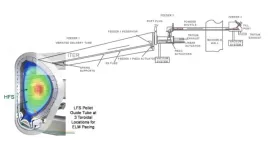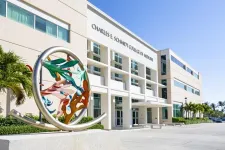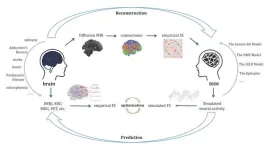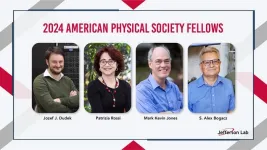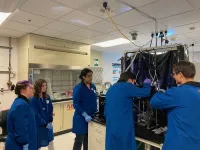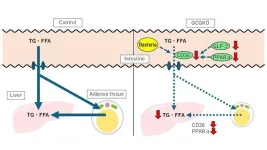(Press-News.org) Researchers have discovered the most distant Milky-Way-like galaxy yet observed. Dubbed REBELS-25, this disc galaxy seems as orderly as present-day galaxies, but we see it as it was when the Universe was only 700 million years old. This is surprising since, according to our current understanding of galaxy formation, such early galaxies are expected to appear more chaotic. The rotation and structure of REBELS-25 were revealed using the Atacama Large Millimeter/submillimeter Array (ALMA), in which the European Southern Observatory (ESO) is a partner.
The galaxies we see today have come a long way from their chaotic, clumpy counterparts that astronomers typically observe in the early Universe. “According to our understanding of galaxy formation, we expect most early galaxies to be small and messy looking,” says Jacqueline Hodge, an astronomer at Leiden University, the Netherlands, and co-author of the study.
These messy, early galaxies merge with each other and then evolve into smoother shapes at an incredibly slow pace. Current theories suggest that, for a galaxy to be as orderly as our own Milky Way — a rotating disc with tidy structures like spiral arms — billions of years of evolution must have elapsed. The detection of REBELS-25, however, challenges that timescale.
In the study, accepted for publication in Monthly Notices of the Royal Astronomical Society, astronomers found REBELS-25 to be the most distant strongly rotating disc galaxy ever discovered. The light reaching us from this galaxy was emitted when the Universe was only 700 million years old — a mere five percent of its current age (13.8 billion) — making REBELS-25’s orderly rotation unexpected. “Seeing a galaxy with such similarities to our own Milky Way, that is strongly rotation-dominated, challenges our understanding of how quickly galaxies in the early Universe evolve into the orderly galaxies of today's cosmos,” says Lucie Rowland, a doctoral student at Leiden University and first author of the study.
REBELS-25 was initially detected in previous observations by the same team, also conducted with ALMA, which is located in Chile’s Atacama Desert. At the time, it was an exciting discovery, showing hints of rotation, but the resolution of the data was not fine enough to be sure. To properly discern the structure and motion of the galaxy, the team performed follow-up observations with ALMA at a higher resolution, which confirmed its record-breaking nature. “ALMA is the only telescope in existence with the sensitivity and resolution to achieve this,” says Renske Smit, a researcher at Liverpool John Moores University in the UK and also a co-author of the study.
Surprisingly, the data also hinted at more developed features similar to those of the Milky Way, like a central elongated bar, and even spiral arms, although more observations will be needed to confirm this. “Finding further evidence of more evolved structures would be an exciting discovery, as it would be the most distant galaxy with such structures observed to date,” says Rowland.
These future observations of REBELS-25, alongside other discoveries of early rotating galaxies, will potentially transform our understanding of early galaxy formation, and the evolution of the Universe as a whole.
More information
This research is presented in a paper entitled “REBELS-25: Discovery of a dynamically cold disc galaxy at z=7.31” to appear in Monthly Notices of the Royal Astronomical Society.
The observations were conducted as part of the ALMA Large Program REBELS: Reionization Era Bright Emission Lines Survey.
The team is composed of L. E. Rowland (Leiden Observatory, Leiden University, the Netherlands [Leiden]), J. Hodge (Leiden), R. Bouwens (Leiden), P. M. Piña (Leiden), A. Hygate (Leiden), H. Algera (Astrophysical Science Center, Hiroshima University, Japan [HASC]; National Astronomical Observatory of Japan, Japan), M. Aravena (Núcleo de Astronomía, Facultad de Ingeniería y Ciencias, Universidad Diego Portales, Chile), R. Bowler (Jodrell Bank Centre for Astrophysics, University of Manchester, UK), E. da Cunha (International Centre for Radio Astronomy Research, University of Western Australia, Australia; ARC Centre of Excellence for All Sky Astrophysics in 3 Dimensions), P. Dayal (Kapteyn Astronomical Institute, University of Groningen, the Netherlands), A. Ferrara (Scuola Normale Superiore, Italy [SNS]), T. Herard-Demanche (Leiden), H. Inami (HASC), I. van Leeuwen (Leiden), I. de Looze (Sterrenkundig Observatorium, Ghent University, Belgium), P. Oesch (Department of Astronomy, University of Geneva, Switzerland; Cosmic Dawn Center, Denmark), A. Pallottini (SNS), S. Phillips (Astrophysics Research Institute, Liverpool John Moores University, UK [LJMU]), M. Rybak (Faculty of Electrical Engineering, Delft University of Technology, the Netherlands; Leiden; Netherlands Institute for Space Research, the Netherlands), S. Schouws (Leiden), R. Smit (LJMU), L. Sommovigo (Center for Computational Astrophysics, Flatiron Institute, USA), M. Stefanon (Departament d’Astronomia i Astrofísica, Universitat de València, Spain; Grupo de Astrofísica Extragaláctica y Cosmología, Universitat de València, Spain), P. van der Werf (Leiden).
The Atacama Large Millimeter/submillimeter Array (ALMA), an international astronomy facility, is a partnership of ESO, the U.S. National Science Foundation (NSF) and the National Institutes of Natural Sciences (NINS) of Japan in cooperation with the Republic of Chile. ALMA is funded by ESO on behalf of its Member States, by NSF in cooperation with the National Research Council of Canada (NRC) and the National Science and Technology Council (NSTC) in Taiwan and by NINS in cooperation with the Academia Sinica (AS) in Taiwan and the Korea Astronomy and Space Science Institute (KASI). ALMA construction and operations are led by ESO on behalf of its Member States; by the National Radio Astronomy Observatory (NRAO), managed by Associated Universities, Inc. (AUI), on behalf of North America; and by the National Astronomical Observatory of Japan (NAOJ) on behalf of East Asia. The Joint ALMA Observatory (JAO) provides the unified leadership and management of the construction, commissioning and operation of ALMA.
The European Southern Observatory (ESO) enables scientists worldwide to discover the secrets of the Universe for the benefit of all. We design, build and operate world-class observatories on the ground — which astronomers use to tackle exciting questions and spread the fascination of astronomy — and promote international collaboration for astronomy. Established as an intergovernmental organisation in 1962, today ESO is supported by 16 Member States (Austria, Belgium, Czechia, Denmark, France, Finland, Germany, Ireland, Italy, the Netherlands, Poland, Portugal, Spain, Sweden, Switzerland and the United Kingdom), along with the host state of Chile and with Australia as a Strategic Partner. ESO’s headquarters and its visitor centre and planetarium, the ESO Supernova, are located close to Munich in Germany, while the Chilean Atacama Desert, a marvellous place with unique conditions to observe the sky, hosts our telescopes. ESO operates three observing sites: La Silla, Paranal and Chajnantor. At Paranal, ESO operates the Very Large Telescope and its Very Large Telescope Interferometer, as well as survey telescopes such as VISTA. Also at Paranal ESO will host and operate the Cherenkov Telescope Array South, the world’s largest and most sensitive gamma-ray observatory. Together with international partners, ESO operates ALMA on Chajnantor, a facility that observes the skies in the millimetre and submillimetre range. At Cerro Armazones, near Paranal, we are building “the world’s biggest eye on the sky” — ESO’s Extremely Large Telescope. From our offices in Santiago, Chile we support our operations in the country and engage with Chilean partners and society.
Links
Research paper
Photos of ALMA
For journalists: subscribe to receive our releases under embargo in your language
For scientists: got a story? Pitch your research
Contacts
Lucie Rowland
Leiden Observatory, University of Leiden
Leiden, The Netherlands
Tel: +31 71 527 2727
Email: lrowland@strw.leidenuniv.nl
Jacqueline Hodge
Leiden Observatory, University of Leiden
Leiden, The Netherlands
Tel: +31 71 527 8450
Email: hodge@strw.leidenuniv.nl
Renske Smit
Astrophysics Research Institute, Liverpool John Moores University
Liverpool, UK
Tel: +44-151-231-2922
Email: R.Smit@ljmu.ac.uk
Bárbara Ferreira
ESO Media Manager
Garching bei München, Germany
Tel: +49 89 3200 6670
Cell: +49 151 241 664 00
Email: press@eso.org
END
Space oddity: Most distant rotating disc galaxy found
2024-10-07
ELSE PRESS RELEASES FROM THIS DATE:
How a common economic theory could help save endangered frogs
2024-10-07
A common theory that guides financial investment strategies may be a handy tool to protect an endangered Puerto Rican frog. A new study uses modern portfolio theory to identify future “investments” in natural resource management that may help managers decide which actions to take to protect coquí llanero populations in Puerto Rico.
The 17 species of coquí frogs, and their signature high-pitched chirp, are considered unofficial mascots of Puerto Rico. The entire population of coquí llanero frogs, the smallest and possibly most endangered of the island’s coquís, ...
Stopping off-the-wall behavior in fusion reactors
2024-10-07
Fusion researchers are increasingly turning to the element tungsten when looking for an ideal material for components that will directly face the plasma inside fusion reactors known as tokamaks and stellarators. But under the intense heat of fusion plasma, tungsten atoms from the wall can sputter off and enter the plasma. Too much tungsten in the plasma would substantially cool it, which would make sustaining fusion reactions very challenging. Now, researchers at the U.S. Department of Energy’s Princeton Plasma Physics Laboratory (PPPL) have experimental results suggesting that sprinkling ...
Real-time cancer diagnostics and therapy through theranostics
2024-10-07
Developing new cancer treatment tools, using imaging techniques such as PET-CT and MRI, and new radiopharmaceuticals for next-generation personalized therapies (“Theranostics”) to target cancer first at the “diagnosis” phase and then at the “therapy” phase, using the same biological targets (“see to treat”). Additionally, the project aims to develop and implement AI-based tools for data sharing among research and hospitals, supporting clinical decisions and predicting individual patient treatment response and outcome.
This is the main ...
Researchers confront new US and global challenges in vaccinations of adults
2024-10-07
Vaccines to prevent common and serious infectious diseases have had a greater impact on improving human health than any other medical advance of the 20th century, surpassing even sanitation and potable water. From the global eradication of smallpox in 1980 to the unprecedented development of effective and safe mRNA vaccines for COVID-19, vaccinations have played crucial roles in preventing millions of premature deaths and hospitalizations in adults and children.
These monumental efforts have involved coordinated local, regional, national and international organizations and dedicated clinical ...
NCSA building stronger connections among observatories, astronomers
2024-10-07
With hundreds of observatories scattered throughout the world, there has never been a better time for astronomers to observe the infinite universe that lies beyond Earth. At any moment in time, a telescope pointed at the night sky can observe new transient phenomena, such as supernovae that brighten rapidly and then fade away over days to months, releasing massive amounts of energy in the process. These events are rare in any single galaxy and each gives researchers more insight into the dynamic time-domain sky.
But what if these observatories could work even closer together to view these important astronomical events?
The National ...
Latest advances in brain network models for medical applications: A comprehensive review highlights future potential
2024-10-07
A research team from the International Research Institute for Artificial Intelligence at Harbin Institute of Technology, Shenzhen, has recently published a comprehensive review in the journal Health Data Science on the application of Brain Network Models (BNMs) in the medical field. This study summarizes recent advances and challenges in using BNMs to simulate brain activities, understand neuropathological mechanisms, evaluate therapeutic effects, and predict disease progression.
Brain Network Models ...
Jefferson Lab physicists named APS Fellows
2024-10-07
NEWPORT NEWS, VA – Four physicists affiliated with the U.S. Department of Energy’s Thomas Jefferson National Accelerator Facility have been selected by their peers for the distinct honor of Fellow of the American Physical Society.
“Our staff power the science and innovation that are continuing to move the discipline of physics and this laboratory into the future,” said Jefferson Lab Director Kim Sawyer. “We’re very proud that the accomplishments and contributions of these four Jefferson Lab staff members to the field of physics are being recognized by their peers with this honor.”
According to the APS, fellows have made ...
Bias found when drug manufacturers fund clinical trials
2024-10-07
COLUMBUS, Ohio – Psychiatric drugs are reported to be about 50% more effective in clinical trials funded by the drug’s manufacturer than when trials of the same drug are sponsored by other groups, new research shows.
While many studies have found more favorable results for drugs in clinical trials funded by their manufacturers, these studies normally just compare a set of manufacturer-funded studies with a set of studies funded in other ways, said Tamar Oostrom, assistant professor of economics at The Ohio State University, who conducted this new research.
This ...
The University of Texas at San Antonio is advancing space exploration as the lead of a multimillion-dollar DOE project
2024-10-07
UTSA was selected by the U.S. Department of Energy’s (DOE) Office of Nuclear Energy (NE) to lead a multimillion-dollar project that will stimulate nuclear energy research at UTSA, leverage novel experimental data to bolster computational efforts at the university, and provide professional training to prepare undergraduate and graduate students for careers in nuclear energy science. UTSA researchers will collaborate with a leading nuclear energy laboratory as well as across academic institutions.
The award is part of the DOE’s Nuclear Energy University Program’s Integrated Research Projects (IRPs). These projects aim to provide research and development solutions ...
Gut hormones could hold the key to fighting fatty liver disease
2024-10-07
The accumulation of fats in the liver is driven by high-fat diets and obesity, and is becoming an increasingly prevalent global health concern. Characterized by excessive fat accumulation in the liver, this condition poses significant risks for various metabolic disorders. While much of the existing research has focused on fat metabolism within the liver itself, emerging findings emphasize the critical role of the gut in this complex process. Proglucagon-derived peptides (PGDPs), including glucagon, GLP-1, and GLP-2, are known to be the key hormones that regulate lipid metabolism in the liver. Derived from the same precursor—proglucagon, previous studies ...



